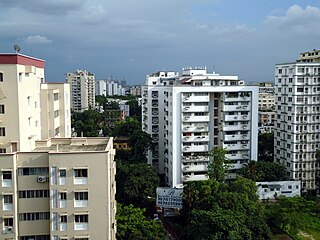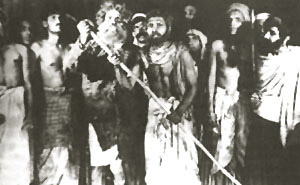Bengali Brahmos are those who adhere to Brahmoism, the philosophy of Brahmo Samaj which was founded by Raja Rammohan Roy. A recent publication describes the disproportionate influence of Brahmos on India's development post-19th Century as unparalleled in recent times.

Ballygunge is a locality of South Kolkata in Kolkata district in the Indian state of West Bengal. It is one of the city's most affluent neighbourhoods.

Kalighat painting, Kalighat Patachitra, or Kalighat Pat is a style of Indian paintings which originated in the 19th century. It was first practiced by a group of specialized scroll painters known as the patuas in the vicinity of the Kalighat Kali Temple in Kolkata, in the present Indian state of West Bengal. Composed of bold outlines, vibrant colour tones, and minimal background details, these paintings and drawings were done on both hand-made and machine manufactured paper. The paintings depicted mythological stories, figures of Hindu gods and goddesses, as well as scenes from everyday life and society, thereby recording a socio-cultural landscape which was undergoing a series of transitions during the 19th and early 20th century, when the Kalighat pat reached its pinnacle.

The culture of West Bengal is an Indian culture which has its roots in Bengali literature, music, fine arts, drama and cinema. Different geographic regions of West Bengal have subtle as well as more pronounced variations between each other, with Darjeeling Himalayan hill region and Duars showing particularly different socio-cultural aspects.

Bengali theatre primarily refers to theatre performed in the Bengali language. Bengali theatre is produced mainly in West Bengal, and in Bangladesh. The term may also refer to some Hindi theatres which are accepted by the Bengali people.

Gurusaday Dutt was a civil servant, folklorist, and writer. He was the founder of the Bratachari Movement in the 1930s.
The Bratachari movement was a movement for spiritual and social improvement in bengal initiated by Gurusaday Dutt in 1932. The movement aimed to raise the self-esteem and national awareness of people of undivided bengal regardless of their religion, caste, sex or age. It was a comprehensive programme of physical, mental, and intellectual culture, based on folk traditions of physical exercise, art, dance, drama, music, singing and social service. The Bratacharis undertake to perform good deeds, strengthen fellowship and develop the mind and body through dance.
Gurusaday Dutt Road is one of the areas of Kolkata. Its old name was Ballygunge Store Road. It was named after Gurusaday Dutt, an ICS officer and a Bengali patriot.
Barun De was an Indian historian. He served as the first professor of social and economic history of the Indian Institute of Management, Calcutta, founder-director of the Centre for Studies in Social Sciences, Calcutta and the Maulana Abul Kalam Azad Institute of Asian Studies, Kolkata and as the honorary state editor for the West Bengal District Gazetteers. He was chairman of the West Bengal Heritage Commission.
Brajendranath Dey was an early Indian member of the Indian Civil Service.

Nakshi kantha, a type of embroidered quilt, is a centuries-old Bengali art tradition of the Bengal region, notably in Bangladesh and the Indian states of West Bengal, Tripura, and parts of Assam. The basic materials used are thread and old cloth. Nakshi kanthas are made throughout Bangladesh, primarily in the areas of Mymensingh, Jamalpur, Bogra, Rajshahi, Faridpur, Jessore, and Chittagong.
Aroti Dutt (1924–2003) was a social worker from India. She was the world president of the Associated Countrywomen of the World for two terms, from 1965 to 1971, and subsequently their Member of Honour. She was also the international vice-president of International Alliance of Women. In India, she was the president of the Saroj Nalini Dutt Memorial Association, an organisation dedicated to Women's work, from 1970 to 2003. She had worked in various capacities in that organisation since 1942. She also founded various other social welfare organisations in India and was associated with many others. She was a graduate of the University of Calcutta and had a Diploma in Social Welfare from the Institute of Social Studies of The Hague, The Netherlands.
Biswas is a native Bengali surname, commonly used by the Bengali community of India and Bangladesh. The surname was an honorary title bestowed on persons who were relied upon for the work of accounts, receipts and expenditure. The word Biswas means faith or trust in Bengali.

Patha Bhavan is an English Medium private co-educational day school in Kolkata, India, which is affiliated to the state secondary and higher secondary boards. It is one of the old schools in Kolkata. It was established on 28 June 1965.
Pijush Ganguly was a noted Bengali film, television and theater actor. In 2005 he received the Bengal Film Journalists' Association Award for the Best Actor in a Supporting Role for his performance in Mahulbanir Sereng.

Bhavani Prasad Bhattacharyya was an Indian revolutionary and member of the Bengal Volunteers who carried out assassinations against British colonial officials in an attempt to secure Indian independence.









